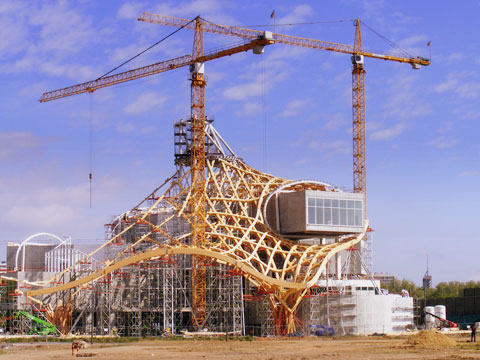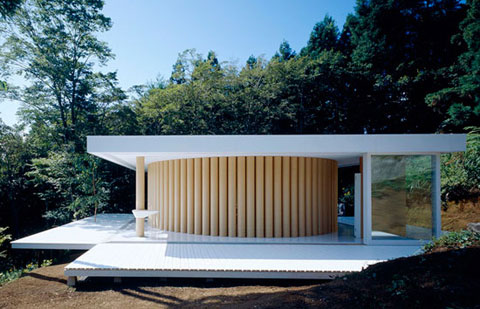
shigeru ban
was born in 1957 in tokyo, japan.
he studied at the southern california institute of architecture
from 1977 - 80, later furthering his studies at the cooper union
school of architecture from 1980 graduating in 1984.
he began his career working for japanese architect arata isozaki
before establishing his own private practice in 1985. ban became
internationally recognized for his work with paper and recycled
cardboard tubes which he used to create temporary structures
for victims of the kobe earthquake in 1995. that same year he
established NGO: VAN (voluntary architects network).
he has taught at numerous schools including the tama art
university, yokohama national university, nihon university,
columbia university and keio university. throughout his career
he has received many awards including the 'best young architect
of the year' award from the japan institute of architecture in 1997,
as well as the world architecture award for his design of the
'japan pavillion', 2001 and the 'thomas jefferson medal in
architecture' in 2005.
http://www.shigerubanarchitects.com



the ‘metal shutter house’, located at 524 west 19th street, in manhattan, new york,
is shigeru ban's first condominium residences in the US. the facade motorized
perforated metal shutters serve as light-modulating privacy screen.
the roll-up nature of the facade and the pivoting glass windows open completely,
thus blurring the boundary between the inside and outside
under construction.

in april 2008, Phillips de Pury auctioned shigeru ban’s paper tea house for £31,700.

in june 2008 shigeru ban's artek pavilion kit was auctioned by sotheby’s for $602,500.
see more pictures here and here

agreb airport new terminal comeptition - croatia, 2008 - 2nd prize
courtesy shigeru ban architects

dellis cay villas, 2008
courtesy shigeru ban architects

paper bridge, remoulin, france, 2007
courtesy shigeru ban architects

vasarely pavillion, aix-en-provence, france, 2006
courtesy shigeru ban architects


centre pompidou, metz, france, 2004 - under construction,
courtesy shigeru ban architects
see more images here
 centre pompidou, metz, france, under construction,
centre pompidou, metz, france, under construction,
image © mujepa

paper house, lake yamanaka, yamanashi, japan, 1995
courtesy shigeru ban architects
what is the best moment of the day?
dinner time, as this is the only time I have to relax.
what kind of music do you listen to at the moment?
jazz and classical music.
do you listen to the radio?
yes.
what books do you have on your bedside table?
I've been reading some type of japanese
history book.
do you read design / architecture magazines?
I don't read it I just look over it.
I think its not so important to follow the architectural news.
where do you get news from?
the newspaper.
I assume you notice how women dress.
do you have any preferences?
I prefer the simple look . it also depends on the occasion
its nice to wear different colors for different occasions.
what kind of clothes do you avoid wearing?
I don't like ties and I prefer to wear only black and white
do you have any pets?
no. no time.
when you were a child, did you want to
become an architect?
no, I wanted to be a carpenter.
where do you work on your designs and projects?
anywhere at anytime.
it could be on a plane, train, bus or in my bed.
do you discuss your work with other architects?
I discuss with my staff and partner but not with other architects.
just inside my office.
describe your style, like a good friend of yours would
describe it.
actually my best friends are my partners
... and I have a good friend in paris, in tokyo and new york.
they say that I don't like to come back to things I've already
resolved and many of my structures are not meant to be
permanent. I've always been interested in using material.
in a new way.
how many people work in your office
or are collaborating with you steadily?
I have about 18 people in tokyo, 10 in paris and 5 in new york.
so you regularly travel from new york to tokyo to paris,
that's a busy life. do you have time for family?
I just work, I don't have time for family.
please describe an evolution in your work,
from your first projects to the present day.
I think my work has been continually changing
since the beginning.
do you have a favorite material ?
I particularly like steel, but paper too can be strong
and permanent.
we need to get rid of material prejudices.
who would you like to design something for?
actually I'm interested in designing anything from a chair to a museum, a refugee house to an airport - anything.
I don't have any particular person I want to work with.
I do not choose anyone like refugees or poor people,
I have projects which come to me.
I have seen the works of alvar aalto and where he has
curated every little detail inside his house.
I would like to design everything inside of a building,
but usually we architects do not receive enough of these
projects to be able to do this.
the earthquake shelters, your groundbreaking
work of using non-traditional materials,
are you continuing these projects?
I did a project in sichuan, china last year after the
earthquake, building temporary schools and currently
I'm meeting with some architects in genoa (italy) talking
about the area of l'aquila near rome, you know where the
earthquake happened in april this year.
regarding the use of non-traditional materials, in 2007
I designed a bridge, located over the gardon river in
southern france, it is made almost entirely out of
cardboard tubes.
in 2007 you designed the paper pavillion for
artek / UPS in finland, are you going to continue
to experiment with new materials?
I don't develop many new materials. I usually use existing
material differently. in this instance it was unusual as artek
came to me and asked me to work with this particular
material created from industrial waste of paper and plastic.
this year I have made a seating system with that recycled
composite. the'10-unit system' is based on the ‘L-unit system’
I did back in 1993. L-shaped units which can be combined
to make chairs, benches, seating lines.
what other objects have you created?
most recently a prototype of a light-weight chair that uses
carbon fiber TENAX®, in these days on show at the
tokyo fiber senseware exhibition and a bowl for the small
danish company ‘when objects work’..
I have never designed tableware before,
so it was challenging. I think its interesting to use an idea from
my architecture and convert it into a small object.
the bowls take their shape from the metz centre pompidou -
the geometry is the same. well, actually this is a prototype.
I've tried to make this in wood but we are still in the
developing process. its very difficult to construct due to all
the bending that is required.
its really a new kind of experimentation.
and what else?
some lighting fixtures in the eighties and a few cardboard
chairs for cappellini in 1998. ...and a ball point pencil for
a company in hawaii in 2004.
design is an art form - in the field of design ‘form’
is also used as expression, where do you collocate
your approach?
my main concern is that the product should be functional.
but sometimes you have the choice
between two or more solutions ?
in that instance I would consider what is more functional,
and more economical. I try to be very pragmatic.
is there any designer and/or architect from the past,
you appreciate a lot?
mies van der rohe, my professor john hejduk
from cooper union school of architecture and alvar aalto.
and those still working / contemporary?
I particularly like otto frei otto as I worked with him and
he was very influential to me, emilio ambasz ... many.
what advice would you give to the young?
actually I miss teaching (I quit university last year)
advice? travel!
then you can understand different cultures of the world
and don't depend on the computer.

© All Right Reserved. Copyright © ООО Информагентство СА "Архитектор" ©
Свидетельство о регистрации ИА №ФС1-02297 от 30.01.2007
Управление Федеральной службы по надзору за соблюдением законодательства в сфере массовых коммуникаций и охране культурного наследия по Центральному Федеральному округу.

